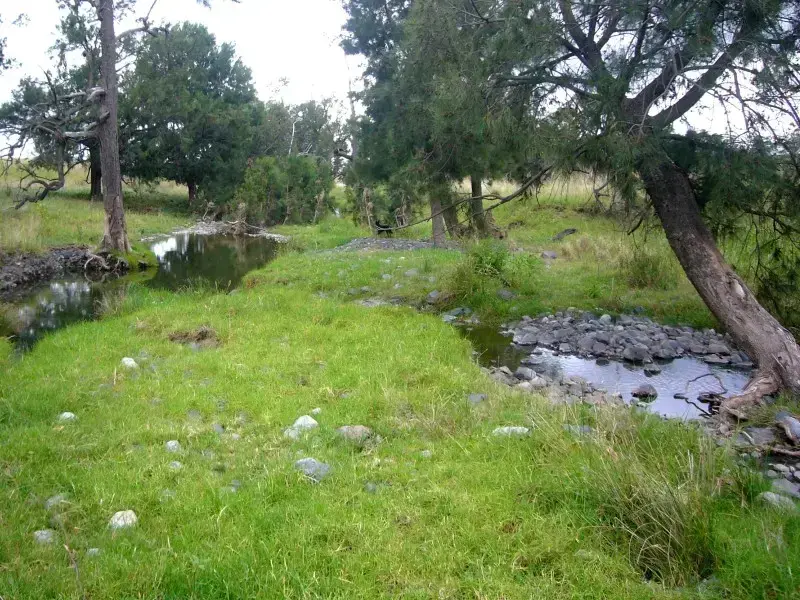‘Tallawang‘
A REGENERATIVE AGRICULTURE CASE STUDY
 Craig Carter and his partner Nicky Chirlian aspire to a balance of low farming inputs, comfortable returns and a healthy diverse landscape. Implementing a combination of water management and grazing practices has restored their landscape hydrology, delivering the productive, greener pastures to support their goal.
Craig Carter and his partner Nicky Chirlian aspire to a balance of low farming inputs, comfortable returns and a healthy diverse landscape. Implementing a combination of water management and grazing practices has restored their landscape hydrology, delivering the productive, greener pastures to support their goal.
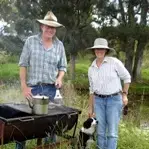 Craig Carter and his partner Nicky Chirlian aspire to a balance of low farming inputs, comfortable returns and a healthy diverse landscape. Implementing a combination of water management and grazing practices has restored their landscape hydrology, delivering the productive, greener pastures to support their goal.
Craig Carter and his partner Nicky Chirlian aspire to a balance of low farming inputs, comfortable returns and a healthy diverse landscape. Implementing a combination of water management and grazing practices has restored their landscape hydrology, delivering the productive, greener pastures to support their goal.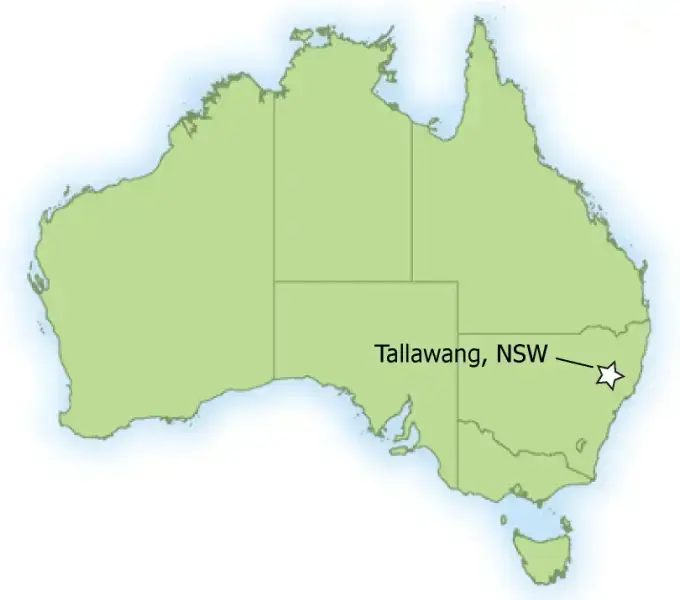
Willow Tree, 60km south-west of Quirindi, NSW North West Slopes and Plains
FARM FACTS
ENTERPRISE: Cattle, sheep. Beef cattle and sheep trading
PROPERTY SIZE: 445 hectares
AVERAGE ANNUAL RAINFALL: 800 mm
ELEVATION: 400-500m
MOTIVATION FOR CHANGE: Disenchantment with ‘traditional’ grazing methods in producing a healthy landscape and adequate returns
INNOVATIONS
- Construction of leaky weirs and swales to slow water flow
- Rotational grazing in wagon-wheel design
- Stock trading
- Innovations commenced: 2002
KEY RESULTS
- 250% increase in carrying capacity
- 15-23% profit margin on cattle production
- Constant river outflow regardless of inflow
- Improved landscape hydrology
- Increased native biodiversity
Introduction
Craig and Nicky both returned to their farming backgrounds after pursuing other careers for a period of time – for Craig, running a financial planning business in Sydney, while Nicky worked in disability services in Armidale. Nicky now runs a private speech pathology practice in Quirindi and surrounding districts.
On arrival at Tallawang in 2001, Craig was concerned about the poor condition of the land – erosion, soil compaction and impoverished pastures – and the severely eroded creek and gullies. He had become disenchanted with his family history of “traditional” land use and set stock grazing on other properties. It was apparent that traditional grazing methods had not produced a healthy landscape nor provided adequate returns. To achieve these outcomes, Craig combined the principles of two newer methods he had encountered, rotational grazing techniques learned through the Grazing for Profit course and water management based on Peter Andrews’ Natural Sequence Farming methods.
Changing Practices
BLENDING PRINCIPLES TO ATTAIN EFFECTIVE HYDROLOGY
When he purchased Tallawang in 2001, Craig’s objective was to establish a low cost, regenerative grazing operation. In terms of obstacles in moving from the traditional farming methods he had grown up with, Craig says, “the main impediment to change is between the ears”.
Drawing from the more contemporary farm management practices he had encountered over the years, Craig and Nicky now apply a blend of the principles of Grazing for Profit and Natural Sequence Farming. These combined techniques have been used to implement a philosophy of low input cost for significant return, using cattle trading and breeding.
The main impediment to change is between the ears.
Craig notes, “We have used a range of management tools that are all designed to be low cost, low impact bumps on mother nature’s side to assist her to rebuild the function of a damaged environment. This is a constant learning process”.
In summary, cell grazing was introduced to Tallawang in 2002. Accessing available grant monies, Yarramanbah Creek, which runs through the property, was fenced and tree corridors were planted. In 2005 a series of leaky weirs was constructed along the length of the creek to retard water flow and enable the original chain of ponds to become re-established.
The existing contour banks in higher country were modified in 2009, by blocking them at intervals, to form swales that retain and more effectively use water in the upper parts of the landscape. This process has enabled surface water to infiltrate higher in the landscape, thus maintaining the quality and quantity of the pasture longer in the drier times, By enabling more water to be absorbed into the soil, the pastures are more lush resulting in the cattle tending to walk less to find the water trough, which is located lower down the slope.

Left: Erosion along the creek had exposed the underlying base of basalt rocks.
Right: Healing erosion along banks as a result of interventions.
Some slashing has been used since 2010 in combination with cell grazing on creek flats to increase soil organic matter and encourage regeneration of native grasses.
As a result, water is retained in the landscape for longer, being readily available for plants and animals. Combined with increased vegetation and soil organic matter, overall landscape hydrology has improved. Craig and Nicky are monitoring these results.
Craig notes, “As we experiment with new tools and expand our skills with old favourites, we aim to record what we have done and the observed responses. Hopefully the landscape function and productivity are improving under our watch”.
CONVERTING THE WATERWAYS
Yarramanbah Creek bisects Tallawang, winding for 4.5km through the property. Average annual rainfall in the region is approximately 800mm, falling mainly from December to February and June to July.
Prior to the 1960s Tallawang was grazed with sheep and cattle. A central bore supplied two small tanks from where water was reticulated to 25 troughs. Yarramanbah Creek had also been used for stock water and was fenced into small paddocks along its length. The banks of the creek and tributaries were incised, with gullies and contour banks further draining water off the property, increasing susceptibility to drought. The creek had eroded down to a base of basalt rocks and stones for its length. Vegetation associated with the creek was characterised by remnant she-oak (Casuarina cunninghamiana) and rough-barked apple (Angophora floribunda) trees. Little regeneration was observed and many of the trees were over-mature and senescent.
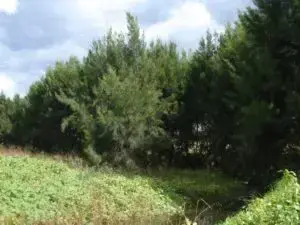
Casurina regrowth and pioneer species covering the old creek bed.
Craig employed Peter Andrews to design creek structures, at a project cost of $17,000, establishing a series of leaky weirs in the creek. These were constructed mainly using dead trees in conjunction with later plantings of common flag reed (Phragmites australis). Potential opposition to this work from the government authorities soon dissipated when the positive environmental effect on retarding flow and creating ponds became evident.
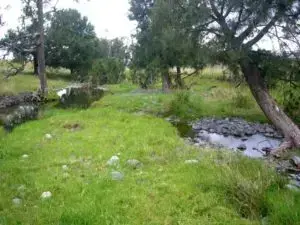
Grassed up basalt rock creek bed forming a chain of ponds.
Six years later, the previously bare soils and gravel beds are covered with regenerating plants – including prolific pioneer plants or weeds but also dense patches of river she-oak seedlings. Considerable siltation is evident as the vegetation traps sediment carried from properties upstream.
Yarramanbah Creek is now a ‘chain of ponds’ with inflow varying according to local rainfall, but constant outflow. Craig’s paddock layout provides cattle water points high in the landscape, which discourages stock from accessing the creek for water and causing any damage to banks.
In 2009 Craig modified the existing contour banks in the higher country by blocking them at intervals to form swales. He also constructed additional swales to further intercept runoff and increase rainfall infiltration in the upper slopes.
Craig states, “Through our work in converting the contour banks constructed in the 1960s into water holding swales, we are restoring the watershed. This process is beginning to restore the hydrological function of the landscape”.
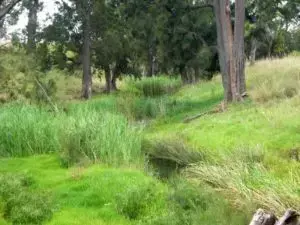
Phragmites australis regenerating along the creek bed.
Improved hydrological function ensures maximum infiltration, extending the growing season of the grasses and providing greener pastures. As a result, Tallawang has become significantly wetter along the upper and mid slopes with increased palatable vegetation later in the drier seasons. Wells that were empty on Craig’s arrival to the property are now full. Previously dry soils along the creek flats are now swampy meadows and wetland plants that did not exist on the property prior to the commencement of the work are in abundance. Rainfall is now available to be used effectively where it falls, rather than being whisked away quickly by poor ground cover with eroded creek lines acting as drains.
FROM BREEDING TO TRADING
The first cattle to graze in the Cattle Creek locality were brought there in 1826 from the Hunter Valley by Benjamin Singleton (after whom the Hunter Valley town is named) and his son-in-law Otto Baldwin. The locality was included in the Warrah Estate, a property of some 100,000 hectares granted to the Australian Agricultural Company in 1833. The land occupied by Tallawang formed one of the paddocks of the Warrah Estate.
When introducing cell grazing in 2002, Craig elected to use a ‘wagon wheel’ fencing design, where paddocks are arranged radiating from a water point at the centre, and single-wire electric fencing for cost-effective grazing management.
To the casual visitor, one of the most obvious differences at Tallawang compared to other cattle properties is the style of fencing used to manage the herd. Gone are the gates – one simply lifts and drives under, or drives over the fences. The internal permanent fences that were present in 2001, that is, closely spaced fence posts and considerable amounts of wire, have been removed.
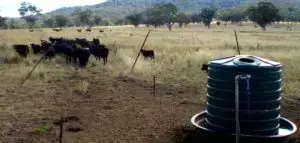 There are now around 100 small triangular shaped paddocks arranged in six cells. At first glance the fences are rather skimpy, comprising sparsely spaced steel posts and a single strand of high-tensile electric wire, running 3000-4000 volts. The simple construction allows fencing layouts to be easily moved or modified to suit landscape needs. Fences are only turned on around individual paddocks being grazed, and the cattle know when the fences are turned on; otherwise they just walk right over the wire. As a general rule each paddock is grazed for no more than three days out of every 90 days.
There are now around 100 small triangular shaped paddocks arranged in six cells. At first glance the fences are rather skimpy, comprising sparsely spaced steel posts and a single strand of high-tensile electric wire, running 3000-4000 volts. The simple construction allows fencing layouts to be easily moved or modified to suit landscape needs. Fences are only turned on around individual paddocks being grazed, and the cattle know when the fences are turned on; otherwise they just walk right over the wire. As a general rule each paddock is grazed for no more than three days out of every 90 days.
Craig manages his property to meet production and landscape outcomes, “Across Tallawang we have gradually increased the stocking rate, based on availability of regenerating native grasses. Cattle are not hand fed [when pastures become depleted] – numbers are managed according to available biomass and rainfall”. To facilitate this, Craig has changed the business from a breeding focus to a trading focus, which entails greater flexibility with stocking rates. Trading cattle enables stocking to be varied as needed to suit seasonal conditions.
“This initiative comes from my experience as a share trader at the Sydney Stock Exchange. At the start of winter, I look to the New England tablelands almost 200km away, where the winters are much harder on pastures than they are on the Liverpool Ranges. At that time cattle producers on the New England are looking to sell their stock to protect their pastures over the harsh cold winter; at the same time I can be looking to buy in cattle to help manage excess grass cover. It is a sound business model for us”, Craig explains.
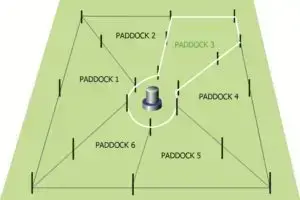
Illustration of a cell of paddocks in a wagon wheel design. This depicts Paddock 3 being grazed, with access to the waterpoint and electric fence turned on.
The stock carrying capacity has increased dramatically with the introduction of time-controlled cell grazing and the restoration of native pastures. In 2002, Tallawang was carrying 218 dairy heifers with an average weight of 300kg. In early 2012, the stock comprises 300 breeding cows plus progeny, as well as 360 ewes with lambs and a further 150 ewes due to lamb in the following month.
“The main tool we have used over the last decade is grazing management. By varying the numbers of stock and using a short graze and long rest period and the paddock size, we are able to encourage the more palatable grasses while the less desirable ones get trampled and can’t compete. The key variable is the timing, frequency and amount of rain”, Craig points out. Craig maintains rolling monthly rainfall data to inform his grazing management, with records for comparison back to 1883.
“Livestock are integral to this process. Like all tools they can be used badly or effectively. Overgrazing has been a cause of a significant amount of degradation in the landscape, merely amending that has had some dramatic positive impacts.”
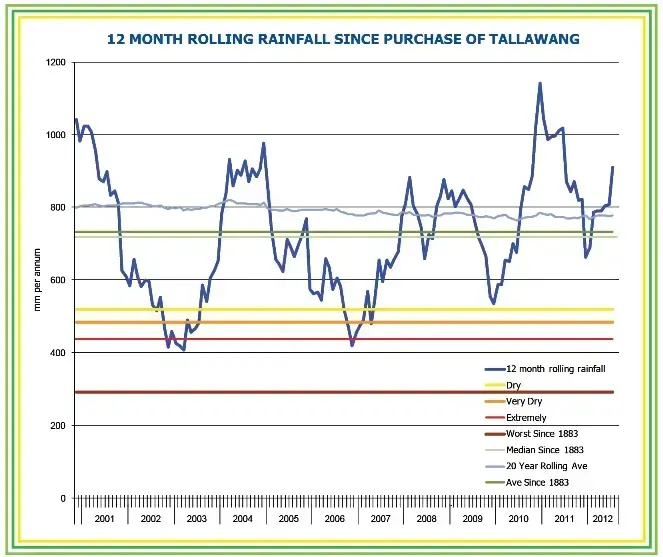
Soil Management
RE-HYDRATING THE SOIL
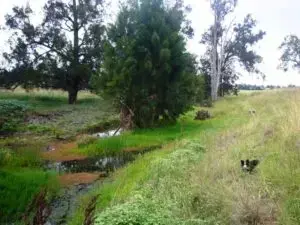 In the lower slopes and narrow riparian plains where Tallawang is located, soils are deep, heavy clay soils (vertisols) derived on weathered basalt. The vertisols, which are widespread in the Liverpool plains region, have high natural fertility. However, when Craig purchased the property in late 2001, Tallawang was typical of most heavy basalt soils, with deficiencies in nitrogen, sulphur and selenium.
In the lower slopes and narrow riparian plains where Tallawang is located, soils are deep, heavy clay soils (vertisols) derived on weathered basalt. The vertisols, which are widespread in the Liverpool plains region, have high natural fertility. However, when Craig purchased the property in late 2001, Tallawang was typical of most heavy basalt soils, with deficiencies in nitrogen, sulphur and selenium.
Reviewing past practices shows how Craig’s approach has improved the hydrology of soil. Anecdotal evidence suggests that cropping was introduced in the 1960s and it is understood that introduction of cropping coincided with extensive earth works. Earth banks were constructed at a slight decline towards the gullies to remove excess soil water and enable cropping. The increased runoff to the drainage lines may have exacerbated the already severe gully and streambed erosion. By 2000, water retention along the upper and mid slopes was poor, increasing the property’s susceptibility to drought.
The effects of the cropping practices prior to 2001 can be seen by a recent comparison of a native pasture site on the property with a cropped site, as shown in the following table. Both sites had the same general history of grazing from the 1820s until the 1960s. The cropped site was cropped from the 1960s to 2000, and even with over ten years of improved management practices, still shows poorer results in terms of ground cover, carbon and nitrogen stores.
| Site (2011) | Native pasture | Cropped |
|---|---|---|
| Ground cover | 95% | 73% |
| Total carbon | 4.9% | 2.4% |
| Total nitrogen | 0.3% | 0.2% |
Increased soil carbon, ground cover, and slowing the flow of water through the leaky weirs has all contributed to improved soil hydrology. Craig notes, “The property has become significantly wetter in higher country with increased vegetation following implementation of swales, and swampy meadows establishing on creek flats”.
Paralleling improvements in the hydrological function has been a steady increase in organic matter in soil. Much of the increased soil carbon has been due to cell grazing over ten years with inputs from cattle manure and humus associated with short term high rotation of cattle. Soil tests from one paddock of native pasture show continuing improvement over time, as presented in the table below.
| Year | 2008 | 2011 |
|---|---|---|
| Total carbon | 2.86% | 4.90% |
| Total nitrogen | 0.27% | 0.30% |
| pH (1:5 water) | 7.18 | 6.6 |
Vegetation Management
PRODUCTIVE GREENER PASTURES
The main tool we have used over the last decade is grazing management.
The original native vegetation of the area surrounding Tallawang was grassy box woodland with sparse eucalypts.
At the time of purchase, Tallawang appeared run down and overgrazed. The property comprised 20% lucerne (for grazing and hay), 5% grazing oats and 75% native and naturalised pasture. Previous management had relied excessively on lucerne for grazing and supplementary feeding of all stock had been required each winter.
By changing the grazing management, Craig has transformed the landscape. There is extensive regeneration of kangaroo grass (Themeda triandra), tall oat grass (Themeda avenacea), lobed blue grass (Bothriochloa biloba) and silky brown top (Eulalia aurea). A gradual decrease in lucerne has been observed through use of cell grazing and some slashing of plains grass, combined with broadcast legumes in 2009. Native trees and shrubs are naturally regenerating.

Pastures with visible exposed bare ground in 2002 (left) now have 95% groundcover and
a significantly increased carrying capacity (right).
By creating the environment to re-establish the chain of ponds along the Yarramanbah Creek there has been observed significant recruitment of varieties of sedges and rushes, notably cigar rush (Lepironia articulata), club rush (Schoenoplectus spp.) and marsh club rush (Bolboschoenus fluviatilis), as well as considerable recruitment of river she-oak, rough-barked apple and native olive (Notelaea microcarpa).
BIODIVERSITY ON TALLAWANG
Plant life observed on the property includes:
Perennial Grasses
- silky brown top (Eulalia aurea)
- kangaroo grass (Themeda triandra)
- tall oat grass (Themeda avenacea)
- blue grass (Dichanthium sericeum subsp. sericeum)
- wallaby grass (Austrodanthonia bipartita)
- Warrego summer grass (Paspalidium jubiflorum)
- water couch (Paspalum distichum)
- wild sorghum (Sorghum leiocladum)
- plains grass (Austrostipa aristiglumis)
- cotton panic (Digitaria brownie)
- hairy panic (Panicum effusum)
- slender bamboo grass (Austrostipa verticillata)
- tall Chloris (Chloris ventricosa)
- lobed blue grass (Bothriochloa biloba)
- red grass (Bothriochloa macra)
Wetland Plants
- spiny-headed mat-rush (Lomandra longifolia)
- spike sedge (Bolboscheonus spp.)
- common flag reed (Phragmites australis)
- cigar rush (Lepironia articulata )
- club rush (Schoenoplectus spp.)
- marsh club rush (Bolboschoenus fluviatilis)
Trees
- white box (Eucalyptus albens)
- river red gum (Eucalyptus camaldulensis)
- Blakely’s red gum (Eucalyptus blakelyi)
- rough-barked apple (Angophora floribunda)
- kurrajong (Brachychiton populneus)
- river she-oak (Casuarina cunninghamiana)
- hickory wattle (Acacia implexa)
- Cooba (Acacia salicina)
- native olive (Notelaea microcarpa)
Weeds on Tallawang are not seen as an area of concern for Craig and no chemicals are used for weed management. His experience has shown that weeds follow a natural sequence, with reductions in weeds, such as Bathurst burr (Xanthium spinosum) and stickybeak (Bidens pilosa), occurring as native pastures increase. Across the property, prickly pear (Opuntia stricta) and sweet briar (Rosa rubiginosa) are the more persistent perennial weeds and these are removed manually. Nearby roadside verges do have some infestation of African love grass (Eragrostis curvula), Coolatai grass (Hyparrhenia hirta), Noogoora burr (Xanthium spp.) and a small amount of St John’s wort (Hypericum perforatum),but these are not problematic on Tallawang.
Outcomes
Attaining balance
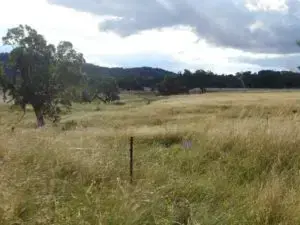
Native grasses have been extensively regenerated through grazing management practices.
Craig’s management practices have transformed the two main soil-landscape types on Tallawang; riparian systems and gently sloping grassy box gum woodlands. Compared to 2001, Tallawang now has more ecological function, restoring what is naturally inherent in grassy woodlands landscapes.
The innovations have resulted in a rehydrated landscape, and the restored ecological function is evidenced by increased ground cover, biomass and soil carbon. The property is becoming increasingly “drought proofed”. There is a broadened diversity of native grasses as they re-emerge from the seed, stabilised creek banks, regenerating riparian vegetation and increased biodiversity.
Numbers and species of small birds and parrots, spiders, frogs and echidnas have increased across the property as a result of the management changes and increase of vegetation cover, particularly native vegetation. Reptiles – geckos, lizards and lace monitors – are seen more frequently. Firetail gudgeons, a small native fish, have been observed in the creek. There are more wetland plants including spiny-headed mat-rush, other rushes, common flag reed and significant regeneration of river she-oak, rough-barked apple and native olive.
In 2012 Tallawang now aims for a 15 to 23% profit on cattle production through breeding and trading programs. Organic matter is increasing and cattle numbers can be managed with very little input costs. Craig has presented on Natural Sequence Farming at various venues and has become a member of the Sydney University Faculty of Agriculture, Food and Natural Resources ‘CANEn’ project – Connecting Agriculture, Nutrition and Environment.
Craig and Nicky have established a personal philosophy for health and life balances. Together they have learned to read their country and landscape and to work with this to enable them to tread lightly on the environment. To ensure the ongoing health of their landscape and their lives they aim, “to be continuously open to new ideas and have the courage to implement them as avenues to meet ongoing goals”.



